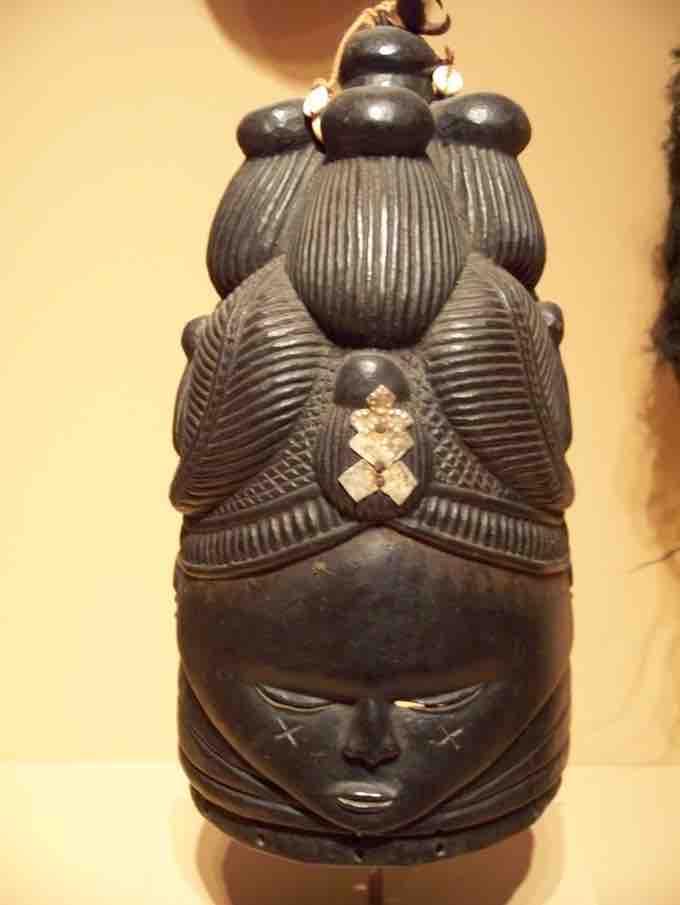Background and Art of the Mendé People
The Mendé people are one of the two largest ethnic groups in Sierra Leone, having roughly the same population as their neighbours the Temne people. Together, the Mendé and Temne both account for slightly more than 30% of the country's total population. The Mendé belong to a larger group of Mande peoples who live throughout West Africa. Mostly farmers and hunters, the Mendé are divided into two groups: the halemo (or members of the hale or secret societies) and the kpowa (people who have never been initiated into the hale). The Mendé believe that all humanistic and scientific power is passed down through the secret societies.
Mendé art is primarily found in the form of jewelry and carvings. The masks associated with the secret societies of the Mendé are probably the best known and are finely crafted in the region. The Mendé also produce beautifully woven fabrics, which are popular throughout western Africa, and gold and silver necklaces, bracelets, armlets, and earrings. The bells on the necklaces are of the type believed capable of being heard by spirits, ringing in both worlds, that of the ancestors and the living.
Mendé Masks
Masks represent the collective mind of the Mendé community; viewed as one body, they are seen as the Spirit of the Mendé people. The Mendé masked figures are a reminder that human beings have a dual existence; they live in the concrete world of flesh and material things as well as in the spirit world of dreams, faith, aspirations, and imagination.
The standard set of Mendé maskers includes about a dozen personalities embodying spirits of varying degrees of power and importance. The most important of these personify and embody the powerful spirits belonging to the medicine societies: the goboi and gbini of the Poro society (the secret society for men), the sowei of the Sande society (the secret society for women), and the njaye and humoi maskers belonging to the eponymous medicine societies. The maskers of the Sande and Poro societies are responsible for enforcing laws and are important symbolic presences in the rituals of initiation and in public ceremonies that mark the coronations and funerals of chiefs and society officials.
Sowei Masks
The features of a Sowei mask convey Mendé ideals of female morality and physical beauty. They are somewhat unusual in that women traditionally wear the masks. The bird on top of the head represents a woman's intuition that lets her see and know things that others can't. The high or broad forehead represents good luck or the sharp, contemplative mind of the ideal Mendé woman. Downcast eyes symbolize a spiritual nature, and it is through these small slits that a woman wearing the mask would look out of. The small mouth signifies the ideal woman's quiet and humble character. The markings on the cheeks are representative of the decorative scars girls receive as they step into womanhood. The neck rolls are an indication of the health of ideal women; they have also been called symbols of the pattern of concentric, circular ripples the Mendé spirit makes when emerging from the water. The intricate hairstyles reveal the close ties within a community of women. The holes at the base of the mask are where the rest of the costume is attached; a woman who wears these masks must not expose any part of her body, or it is believed a vengeful spirit may take possession of her.
When a girl becomes initiated into the Sande society (the Mendé secret society for women), the village's master woodcarver creates a special mask just for her. Helmet masks are made from a section of tree trunk, often of the kpole (cotton) tree, and then carved and hollowed to fit over the wearer's head and face. The woodcarver must wait until he has a dream that guides him to make the mask a certain way for the recipient. A mask must be kept hidden in a secret place when no one is wearing it. These masks appear not only in initiation rituals but also at important events such as funerals, arbitrations, and the installation of chiefs.

Helmet Mendé Mask
Helmet masks of the Mendé, Vai, Gola, Bassa and other peoples of the sub-region are the best documented instance of women's masking in Africa. These masks are used by the Sande association, a powerful organization with social, political and religious significance. Although worn only by women, these masks, as is the case elsewhere in Africa, are carved by men.
Gbini Masks
Gbini is considered to be the most powerful of all Mendé maskers; it appears both at the final ceremony of the Poro initiation process for a son of the paramount chief and also at the coronation of funeral of a paramount chief. Because of its power, women are made to stand far back from gbini and if a woman accidentally touches it, she must be anointed with medicine immediately.
The Gbini wears a large leopard skin which indicates its association with the paramount chief. The flat, round headpiece resembles the chief's crown. The headpiece is constructed of animal hide stretched over a bamboo framework, and the hide is decorated with cowrie shells and black, white, and red strips of cloth that are worked into a geometric pattern. At the center is a round mirror. Several flaps that are similarly decorated hang down from the base of the headpiece and overlap the cape, which covers much of the wearer's torso.
Gbini Mask
Gbini mask, Mende (wood, leopard skin, sheepskin, antelope skin, raffia fiber, cotton cloth, cotton string, cowry shells), from the collection of the Brooklyn Museum